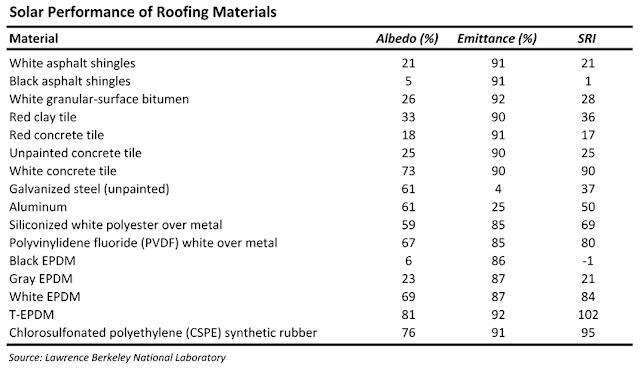What is emittance?
Among the three basic forms of heat transfer - conduction, convection, and radiation - the term emittance refers to a material's ability to release heat through radiation.
The term necessarily refers to the heat exchange at surface of a material because heat exchange through a solid would be conductive and heat exchange through a fluid would be convective.
Emittance is the ratio of the radiation emitted by a given material to that emitted by a "black body" at the same temperature. This unitless value would be 0.0 if no emittance was possible and 1.0 at the ideal maximum - the theoretical "black body" (i.e., a material with an emittance of unity).
The lower the emittance, the lower the radiative heat exchange. Typically, emittance is related to absorptance (i.e., highly absorptive materials will usually have high emittance) - but they are not the same characteristic. With regard to opaque materials, absorptance directly relates to reflectance.
What is reflectance? How is it different than albedo?
Recall that solar radiation striking a surface will either be reflected, absorbed, or transmitted. The combination of those three phenomena will equal 100% (irregardless of emittance). When referring to opaque materials, solar radiation will not transmit. It will only be absorbed or reflected.
Reflectance is the ratio of reflected light to incident light.
Note that reflectance refers specifically to light - the visible portion of the solar electromagnetic radiation spectrum. Light reflectance value (LRV) is a more accurate term for this ratio. The term albedo refers to overall solar radiation reflectance - not just the visible portion of the spectrum. Sometimes albedo is referred to as solar reflectance (SR).
|
Illustration property of Daniel Overbey |
What does emittance mean in practical terms?
Radiation heat transfer is greatly influenced by a material's surface characteristics. Shiny materials are less capable of radiating heat than rougher "matte" surfaces. In general, polished metallic surfaces are poor far–IR absorbers (good reflectors) and are correspondingly poor emitters.
What does reflectance mean in practical terms?
An example of almost perfect reflection from an opaque surface would be a well-silvered mirror. Conversely, a matte-finish black painted object would prompt almost perfect absorption. With any given surface, color will play a role. Lighter-colored surfaces will have a greater LRV. Keep in mind that the angle of light incidence will impact reflectance.
Heat is infrared radiation, but not all infrared radiation is heat.
Solar radiation exhibits a range of wavelengths within the electromagnetic spectrum - from ultraviolet (UV), to visible light, to infrared (IR). The infrared radiation coming from the Sun has a very short wavelength. It is not heat. Solar radiation of any wavelength does not become heat (i.e., thermal energy) until it strikes something on the Earth (or in its atmosphere) and becomes terrestrial long-wave IR radiation.
Anytime heat is radiated from a material's surface, it is long-wave IR radiation, not short-wave IR (like what comes from the Sun).
How does reflectance and emittance work in tandem on "cool roofs"?
With cool roofs, color is typically the first design consideration. However, emittance also matters because the higher the emittance, the more readily the roof surface will radiate long-wave IR (heat) to the sky.
Mindful that reflectance and albedo can be different, a combination of high albedo and high emittance resists solar heat gain most effectively. They can also reduce the urban heat island effect. The concept of solar reflectance index (SRI) emerged to facilitate convenient comparisons among various roofing solutions.
How does the SRI work?
The SRI is a measure of the constructed surface’s ability to stay cool in the Sun by reflecting solar radiation and emitting thermal radiation. It is defined such that a standard black surface (initial solar reflectance 0.05, initial thermal emittance 0.90) has an initial SRI of 0, and a standard white surface (initial solar reflectance 0.80, initial thermal emittance 0.90) has an initial SRI of 100.
How is the SRI calculated?
For a given material, obtain its solar reflectance (albedo) and thermal emittance ratios via the Cool Roof Rating Council standard CRRC-1. SRI is calculated according to ASTM E 1980.
Teams should design with a three-year aged SRI value. The calculation of which is based on the aged tested values of solar reflectance and thermal emittance.
Online Resources
The Heat Island Group at Lawrence Berkeley National Laboratory (LBNL) has provided a free SRI Calculator at: https://heatisland.lbl.gov/resources/technical-resources
LBNL also provides a Cool Roofing Materials Database which lists the solar performance of various roofing materials at: http://energy.lbl.gov/coolroof/

.jpg)


Recent Comments
These are actually very helpful tips. It is...
This is the most beneficial blog for all...
This blog is a great resource for anyone...
Thank you for sharing this important information. I...
This is a very interesting subject of the...